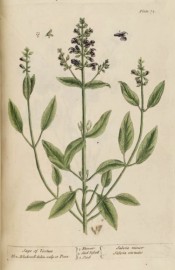Salvia officinalis L.
Fully hardy, erect perennial sub-shrub with oblong, grey-green, woolly, aromatic leaves and terminal or axillary racemes of lilac-blue flowers. To 80cm, spreading. [RHSE, Hortus].
Horticultural & Botanical History
Widely grown in Europe since Roman times as a medicinal and culinary herb. The Latin word ‘dulcis’ means ‘sweet’. According to Johnson’s Dictionary introduced to Britain in 1597 but it was almost certainly earlier than this. Don. ‘Sage of Vertue. Salvia minor or Virtutis. The stalks grow to be 18 inches high, ye leaves are a light green, and ye flowers a pale purple. It grows in gardens and flowers in May and June. It is esteemed good for all diseases of the head and nerves, as ye palsy, convulsions Etc. They use it likewise for uterine obstructions, and in fevers of all sorts. The leaves are used in the Aq. Antepileptica, Antiparalytica, Vitae Composita, Syrup Stoechados, Ung. Martiatum, Caspar Commelin.’ [Blackwell pl.71/1737].
History at Camden Park
Somewhat surprisingly, if this is the correct identification, listed only in the 1857 catalogue [H.209/1857].
Notes
Published Feb 09, 2009 - 04:48 PM | Last updated Jul 25, 2010 - 03:27 PM
| Family | Lamiaceae |
|---|---|
| Category | |
| Region of origin | Mediterranean |
| Synonyms | |
| Common Name | Common sage |
| Name in the Camden Park Record | Salvia dulcis |
| Confidence level | medium |


